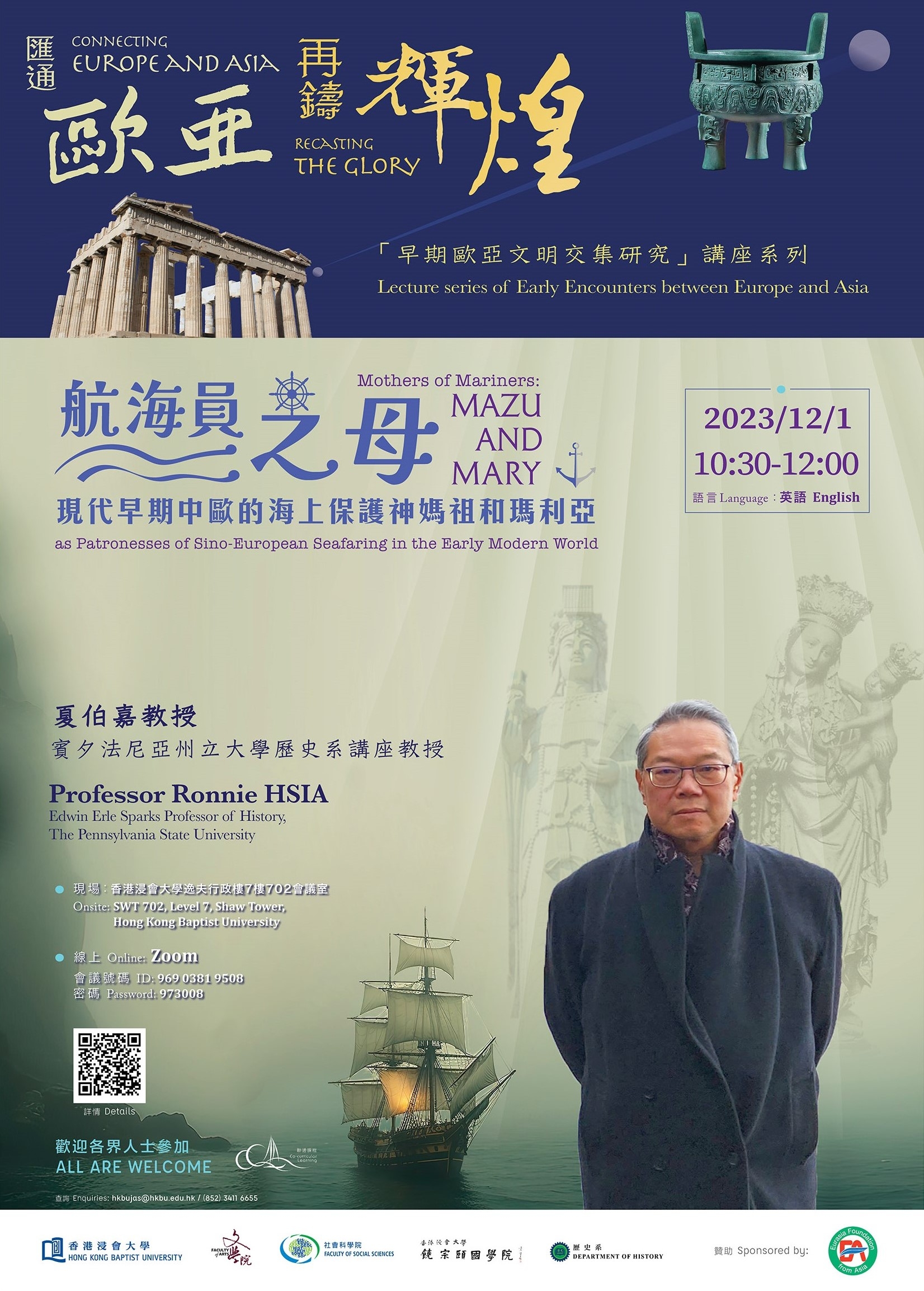
Connecting Europe and Asia, Recasting the Glory: Lecture series of Early Encounters between Europe and Asia
Lecture 8: Mothers of Mariners: Mazu and Mary as Patronesses of Sino-European Seafaring in the Early Modern World
2023/12/1│10:30–12:00
Professor Ronnie HSIA
Edwin Erle Sparks Professor of History,
The Pennsylvania State University
- Abstract: This lecture will compare the roles of Mazu and the Virgin Mary as the respective protectors of Chinese and European sailors between the 13th and 17th centuries. It opens with a brief account of the deification of Mazu and the role of Mary as the Stella Maris, the Maritime protector of sailors. Then I shall offer examples of their roles from contemporary western and Chinese sources. Finally, I shall analyze this history in the context of global, gender, and maritime history.
- Language: English
- Summary (Recorded by Zhang Zixuan)
Professor Ronnie Hsia’s lecture, called ‘Mothers of Mariners: Mazu and Mary as Patronesses of Sino-European Seafaring in the Early Modern World’, through deployment of vivid imagery and rich resources of both depiction and text, compared Mazu and the Holy Mother Mary and the historical facts and cultural background regarding their roles as the patronesses of seafarers of China and Europe respectively from the thirteenth to the seventeenth centuries. The event attracted almost a hundred audience members, both in-person and online, from Hong Kong, the Chinese mainland, Macao, Taiwan, and overseas.
First, Professor Hsia introduced the topic via the A-Ma Temple situated opposite the Maritime Museum in Macao. He outlined to his audience Mazu, who was born in Song dynasty Meizhou in Putian County in Fujian, and the story of her original manifestation as Lady Lin Mo. (In the Ming dynasty, she was conferred the title ‘Heavenly Princess’; in the Qing dynasty, she was conferred the title ‘Heavenly Empress’.) Although faith in her had its origin in Fujian, it was also widely popular in Guangdong, Hong Kong, and Macao, and in these places, many temples dedicated to her can be found.
The Mazu of folk legends has the capacity to assist in childbirth, rescue individuals in distress, request assistance for ships transporting grain, subdue demons, calm the seas’ waves, and has other attributes too, and her achievements in these endeavours are manifold. In the early Ming dynasty, faith in Mazu developed greatly, for example, the Yongle emperor had a Heavenly Princess Palace (Temple) built and consecrated at Shizi Shanlu (The foot of Lion Mountain) and on the banks of the Yangtze River in Nanjing to commemorate Mazu’s achievement of protecting Zheng He’s fleet. Later, in the mid- and later Ming dynasty, when Japanese wokou corsairs and other pirates were harassing coastal areas, a contemporary legend evolved that told how Mazu expelled these pirates.
At the start of the Qing dynasty, Zheng Zhilong’s son Zheng Chenggong occupied Taiwan and established the Dongning regime. In 1683, after Shi Lang had seized Taiwan for the Qing court and established political control, an extremely respectful attitude was adopted towards faith in Mazu in the region. Emperor Kangxi subsequently also approved a proposal in a formal policy document passed upward to him by the Board of Rites to confer on Mazu the title of ‘National Protector, Populace Shielder, Excellent Spirit, Bright Responder, Magnificently Benevolent, Universal Benefiter, Heavenly Princess.’
Closely following this, Professor Hsia also introduced the Spanish Augustinian monk Martin da Rada, the Portuguese Jesuit André Palmeiro, the French Jesuit Louis Lecomte, and others, and their miraculous experiences when crossing the seas around South-east Asia and China. He also discussed their observations and notes regarding the faith that Chinese people had in Mazu and their views and reactions, as Catholic believers, to this faith.
Mazu and the Holy Mother Mary both had their roles as patronesses of respectively Chinese and European seafarers in the early modern era. In the age of discovery, when European Catholic missionaries who had travelled the sea routes encountered China, an intriguing collision arose between the two faiths, which is fascinating. In fact, there are many common features to the two faiths, for example, the Holy Mother Mary also has ‘spiritual power’ to protect the peaceful passage of naval fleets and even to inspire victory in battle, and this is extremely interesting.
- Lecture video
HKBUTube
Bilibili
This lecture series is sponsored by Eurasia Foundation (from Asia).